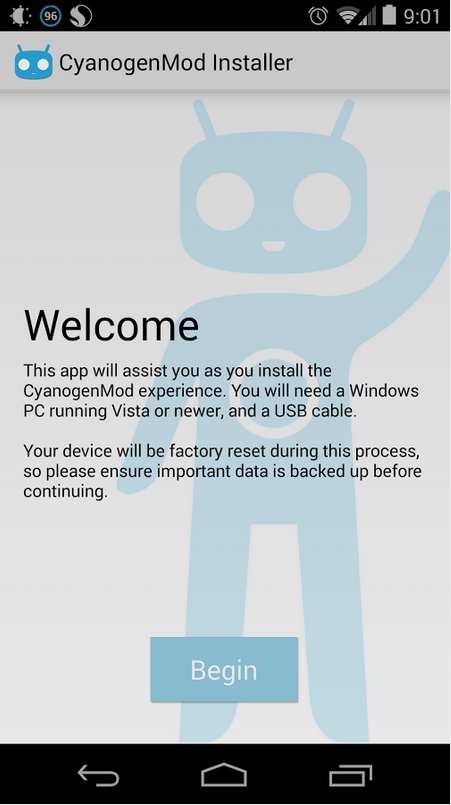CyanogenMod installer now available on Google Play Store

Few things are more annoying to an Android smartphone or tablet owner than wanting to upgrade their device to a newer version of Android but being blocked from doing it by their vendor and/or carrier. Sure you could unlock your device and load an alternative bootloader — if you knew exactly what you were doing. Cyanogen, the company behind the leading alternative Android firmware CyanogenMod has released the first easy-to-use Android bootloader to the Google Play Store: CyanogenMod Installer.

While it's not as simple as click, download, and boot your new Android, the CyanogenMod Installer and its accompanying Windows program, makes upgrading Android devices easier than ever before.
At this time there are only a few dozen devices supported by the Installer. These are all members of the Google Nexus, Samsung Galaxy, and HTC One lines.
You will also need a Windows PC for the CyanogenMod Installer. This assistant program works with Windows Vista, 7, and 8. It does not work with Windows XP. There are plans for a Mac OS X Installer, but none for Linux at this time.
With the pair of programs, you can upgrade the supported devices from their existing version of Android to the CyanogenMod 10.2 M1 Release. This is a version of Android 4.3.
For now, there is no version of CyanogenMod for Android 4.4 "KitKat". The newly minted Android company is working on this.
"We will continue to work on the 10.2 code branch, in parallel to all of our Android 4.4 efforts," the company said. "For those that will inevitably ask, we have not made any decisions with respect to what devices will make the leap to the KitKat code base and likely won't have that information for a few weeks."
Before jumping into upgrading your device, do keep in mind that this is potentially dangerous for your device. With more than nine million downloads, CyanogenMod may be the most popular alternative firmware. However, most of the people who've used it until now have been Android developers or power users.
So, to lessen the chances that you'll brick your device, or at least be in a better position to recovery it if you do brick it, be sure to take the following steps.
First, back up your data. Next (no, really) make sure you backed up your data and that you can read the backup.
Then, make sure your device's battery is fully charged. After that connect your device directly to the Windows PC with a high-quality USB cable. Do not use a USB hub. You must also turn off your anti-virus program during the process. You should also avoid moving the phone around until the install is complete. The last thing you want is to end up accidentally disconnecting the two during the process. Now, follow the instructions and good luck to you.
Still want to give it a go? Good luck! I'm going to wait until tomorrow morning myself before throwing it at my 2012 Nexus 7.
Related stories: